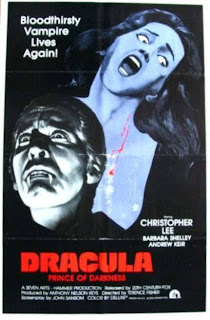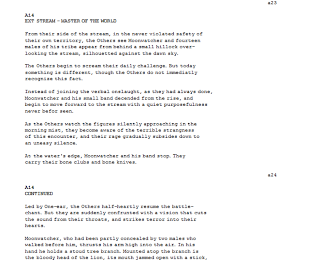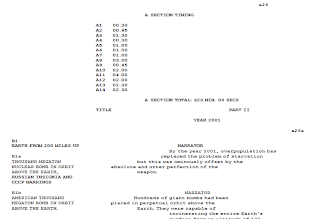Tuesday, November 25, 2008
Personal thoughts on the Test Shoot.
Monday, November 24, 2008
BLK feedback
Also no continuity sequence link or evaluation. I know you have been very involved in the play Daniel but it won't help you to get behind.
Catch up immediately please, I will give you a day or two to sort things out.
Sunday, November 16, 2008
Initial Ideas
Wednesday, November 5, 2008
Evaluation of Preliminary Task
Who did you work with and how did you manage the task between you?
-Working on the preliminary task, my colleagues were Ben, Selina, Hannah and Mel. We all took a part of the task and kept this role throughout; Ben and I shouldered the burden of acting the scene, Selina directed the task, Mel monitored sound, and Hannah operated the camera throughout the scene. This saved time for the crew, as they knew exactly how to operate their equipment.
How did you plan your sequence? What processes did you use?
-An idea for a basic piece of interaction between two characters was thought up, and Ben wrote up a basic script, which was then fine-tuned. We then storyboarded the sequence, thus deciding what was actually going to happen, and what types of shot we would have. Then we wrote up a shooting script, giving us the order in which we needed to film the scenes.
What technology did you use to complete the task, and how did you use it?
- The equipment used while filming consisted of a camera mounted on a tripod, with a microphone and headphones attached. After filming, in post production, we used Adobe Premier Pro to edit the sequence together. This enabled us to cut out the outtakes, re-order the shots, and edit them into a continuous scene, with match on action and similar techniques.
What factors did you take into account when planning, shooting and editing?
-With a limited amount of time for our task, we organised our meetings carefully, making quick decisions between us. The location had to be in a place easy to arrive at, a place that we were allowed to film in and empty at the time that we wanted to film, so we decided on one of our media classrooms. Also, everything on the brief had to be included in the piece.
How successful was your sequence? Please identify what worked well, and with hindsight, what would you improve/ do differently?
-Overall, the sequence worked well. The shots were smooth, and the 180 degree rule remained unbroken. However, we did not get a shot-reverse-shot, and there is no real master shot, as each shot is slightly different. The different levels of the two characters works well, as does the Student's P.O.V. shot. The match on action is very good as well. If I were to it again, I would include more shots from the Student's side of the room, e.g. an over the shoulder shot.
What have you learnt from completing this task? Looking ahead, how will this learning be significant when completing the rest of your foundation coursework, do you think?
-The task has prepared me for using the camera and similar equipment, as well as translating ideas onto storyboards and shooting scripts. This first encounter with editing software has familiarised me with editing techniques, and we have learned the different tasks involved with filming, and if it is best to keep to the same task or keep switching. (There are pros and cons for both, but keeping to the same task is more efficient for the group.)
Tuesday, November 4, 2008
Research: famous film production logos
Another example is at the start of the film "The Core," in which its subject matter of the Earth's core is introduced by the familiar "Paramount Pictures" opening, when suddenly the camera arcs over as it zooms in on the Paramount mountain, then the shot takes a plummet down a crevasse, down, down, down, into the seething magma of the Earth's core. These type of productions use the fact that the introductory themes and logos of these producers are so traditional and well known that the directors can use them to turn things on their heads and make the familiar unfamiliar, but also making it more accessible to the audience.
Researching movie posters
 However, posters that came out later in the advertising campaign focused much more on the stars of the film. At the risk of being cynical, I point out that these posters also do not show much about the plot other than dynamic imagery, this time of the stars that will appear in the film. They rely on the fame of the lead actors to create interest in the film.
However, posters that came out later in the advertising campaign focused much more on the stars of the film. At the risk of being cynical, I point out that these posters also do not show much about the plot other than dynamic imagery, this time of the stars that will appear in the film. They rely on the fame of the lead actors to create interest in the film.
The advertisers rely on the fame of the actor, and then create an intense and dynamic background to excite the audience.
However, if the film is a sequel, part of an established series, the name of the series and an image of the star of that series are familiar enough to introduce the film, and the film merely has to be shown to be as exciting and dynamic as its predecessors.
 This poster for Dracula: Prince of Darkness relys on the established fame and set pieces (e.g. Christopher Lee, beautiful women meeting nasty ends) of the series and its star to attract the audience that has seen the previous Dracula films.
This poster for Dracula: Prince of Darkness relys on the established fame and set pieces (e.g. Christopher Lee, beautiful women meeting nasty ends) of the series and its star to attract the audience that has seen the previous Dracula films.
Research: Scripting


These screenshots from a movie script (2001: A Space Odyssey) show the huge emphasis on explicit direction in the script. There are large chunks written describing each individual shot. The script does not actually describe the shot, but gives a huge amount of plot detail, telling the story as it would be in a book. From this, the director creates a scene, with appropriate direction based on the story as they have been told in the script. The scripr then directs how long each shot and the the section as a whole are expected to last. This means that the director knows how much time to aim to show the scene in.
The dialogue of the script runs down the centre of the page, while the images that are going to be displayed during this are shown to the left. Thus the director, reading the script, can match the scene directions up to the scripted speech.

In this extract from a television script (Spooks) the differences are obvious. The directions are much more concise and to the point, giving the scene, the people and objects in it, and the ages of any characters introduced in the shot. This is followed by the dialogue of the characters as scripted, with the action interspersed as it happens in the scene. This means that the director and actors already know when events happen within a scene.
This shows that movie directors are given much more responsibility within exactly what happens within a scene and when, and that, more importantly, they are allowed a larger interpretation of the narrative. In comparison, television directors have a less prominent job, but still have an important task in set design, deciding on the "look" of the set, and the type of shots used in the scene. It is worth noting that movie directors usually achieve far greater fame than those in television.

